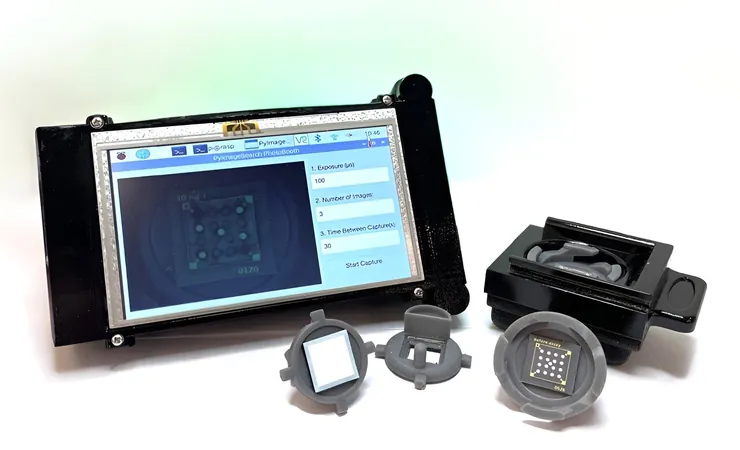
Revolutionary Paper-Based Sensor: Diagnose Heart Attacks in Just 15 Minutes!
2024-10-06
Author: Siti
Introduction
In a groundbreaking development in medical diagnostics, researchers from UCLA have unveiled an innovative deep learning-enhanced paper-based vertical flow assay (VFA) that can detect cardiac troponin I (cTnI) with remarkable sensitivity. This new technology promises to revolutionize access to rapid and accurate cardiac diagnostics, especially in regions that lack sophisticated medical infrastructure.
Significance of Early Detection
Cardiovascular diseases continue to dominate as the leading cause of death globally, responsible for over 19 million fatalities each year. The key to improving patient outcomes lies in the early detection of acute myocardial infarction (AMI)—commonly known as a heart attack. Unfortunately, traditional laboratory tests, with their high costs and infrastructure demands, often limit timely access to quality medical care, particularly in low- and middle-income countries.
Development of hs-VFA
In response to this urgent need, the UCLA research team developed what they have termed a high-sensitivity vertical flow assay (hs-VFA). This pioneering solution merges the accuracy of traditional laboratory testing with the simplicity and cost-effectiveness of point-of-care technology. Documented in their recent publication in the journal ACS Nano, the hs-VFA can determine cTnI levels within a mere 15 minutes using a small serum sample, making it highly suitable for emergency situations and remote locations.
Technology Behind hs-VFA
The remarkable capabilities of this platform arise from a combination of advanced deep learning algorithms and innovative nanoparticle amplification methods. Using time-lapse imaging and computational analysis, the hs-VFA enhances the detection of cTnI, a significant marker for cardiac injury, with a sensitivity capable of detecting levels as low as 0.2 picograms per milliliter (pg/mL). This level of detection sensitivity not only outshines existing point-of-care devices but also adheres to the critical requirements for high-sensitivity troponin testing vital for the preliminary diagnosis of heart attacks.
Professor Ozcan's Insights
Professor Aydogan Ozcan, senior author of the study, expressed enthusiasm about the project's potential, stating, "This low-cost, portable solution bridges the gap between traditional lab diagnostics and point-of-care testing, making advanced cardiac diagnostics accessible to underserved populations around the world."
Mechanism of Action
The hs-VFA operates in a two-step process: initially, an immunoassay binds gold nanoparticle conjugates to the cTnI in the serum. Following this, a signal amplification phase triggers a color change using catalyzed gold ions, which is captured by a specially-designed portable reader. Deep learning algorithms then analyze the captured images, enhancing both the sensitivity and precision of cTnI detection.
Testing and Performance
Testing of the hs-VFA has shown impressive results, with less than 7% coefficient of variation (CV) and a robust correlation with standard laboratory analyzers. Its extensive detection range spans from as low as 0.2 pg/mL to 100 nanograms per milliliter (ng/mL), facilitating not only the diagnosis of heart attacks but also ongoing monitoring of patients at risk.
Cost-Effectiveness
Cost-effectiveness is another crucial highlight of this platform. Each paper-based assay is priced under $4, while the portable reader, crafted using a Raspberry Pi and affordable components, retails for around $170. This budget-friendly approach holds the potential to enhance access to quality diagnostics in resource-poor settings where conventional lab facilities may not exist.
Expert Commentary
Dr. Gyeo-Re Han, the lead author of the study, emphasized the system's versatility, declaring, "Our goal was to develop a device applicable not just in hospitals but in pharmacies, clinics, and even ambulances. Rapid troponin level detection can significantly speed up treatment for heart attack patients, especially during the crucial pre-hospital phase."
Future Applications
Beyond its cardiac applications, the researchers believe the hs-VFA platform may be suitable for detecting other critical low-abundance biomarkers, paving the way for its adaptation in various medical diagnostic fields. Its portable, easy-to-use design makes it a viable contender against centralized lab testing for numerous health conditions—offering newfound hope for improved global health outcomes.
Collaborative Efforts
This milestone was achieved through collaborative efforts between the UCLA Departments of Electrical & Computer Engineering, Bioengineering, and the California NanoSystems Institute. With this remarkable advancement, the future of cardiac diagnostics looks brighter than ever!





 Brasil (PT)
Brasil (PT)
 Canada (EN)
Canada (EN)
 Chile (ES)
Chile (ES)
 España (ES)
España (ES)
 France (FR)
France (FR)
 Hong Kong (EN)
Hong Kong (EN)
 Italia (IT)
Italia (IT)
 日本 (JA)
日本 (JA)
 Magyarország (HU)
Magyarország (HU)
 Norge (NO)
Norge (NO)
 Polska (PL)
Polska (PL)
 Schweiz (DE)
Schweiz (DE)
 Singapore (EN)
Singapore (EN)
 Sverige (SV)
Sverige (SV)
 Suomi (FI)
Suomi (FI)
 Türkiye (TR)
Türkiye (TR)